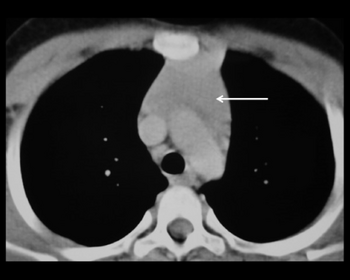Thymus hyperplasia
| Thymus hyperplasia | |
|---|---|
| Other names: Thymic hyperplasia | |
 | |
| Thymic hyperplasia | |
Thymus hyperplasia refers to an enlargement ("hyperplasia") of the thymus.[1]
It is not always a disease state. The size of the thymus usually peaks during adolescence and atrophies in the following decades. Before the immune function of the thymus was well understood, the enlargement was sometimes seen as a cause for alarm, and justification for surgical reduction. This approach is much less common today.
It can be associated with myasthenia gravis.[2][3] Magnetic Resonance Imaging can be used to distinguish it from thymoma.[4]
Thymic hyperplasia can be divided into three groups namely, those without any pre-existing medical condition, those recovering from a pre-existing medical condition such as pneumonia, corticosteroid therapy, radiation therapy, chemotherapy, surgery, and burns, and those with other disorders such as hyperthyroidism, sarcoidosis, or pure red cell aplasia.[5]
References
- ↑ "eMedicine - Surgery of the Thymus Gland : Article by Said Fadi Yassin". 2019-02-26. Archived from the original on 2008-10-16. Retrieved 2022-07-28.
{{cite journal}}: Cite journal requires|journal=(help) - ↑ "Thymus, hyperplasia". Medcyclopaedia. General Electric. Archived from the original on 2011-05-26. Retrieved 2022-07-28.
- ↑ Murakami M, Hosoi Y, Negishi T, et al. (November 1996). "Thymic hyperplasia in patients with Graves' disease. Identification of thyrotropin receptors in human thymus". Journal of Clinical Investigation. 98 (10): 2228–34. doi:10.1172/JCI119032. PMC 507671. PMID 8941638.
- ↑ Inaoka T, Takahashi K, Mineta M, et al. (June 2007). "Thymic hyperplasia and thymus gland tumors: differentiation with chemical shift MR imaging". Radiology. 243 (3): 869–76. doi:10.1148/radiol.2433060797. PMID 17463136. Archived from the original on 2017-09-21. Retrieved 2022-07-28.
- ↑ Nasseri, Farbod; Eftekhari, Farzin (March 2010). "Clinical and Radiologic Review of the Normal and Abnormal Thymus: Pearls and Pitfalls". RadioGraphics. 30 (2): 413–428. doi:10.1148/rg.302095131. ISSN 0271-5333. PMID 20228326. Archived from the original on 2022-08-06. Retrieved 2022-07-28.
External links
| Classification |
|---|